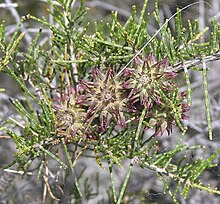| Allocasuarina thuyoides | |
|---|---|

| |
| In Cape Arid National Park | |
| Scientific classification | |
| Kingdom: | Plantae |
| Clade: | Tracheophytes |
| Clade: | Angiosperms |
| Clade: | Eudicots |
| Clade: | Rosids |
| Order: | Fagales |
| Family: | Casuarinaceae |
| Genus: | Allocasuarina |
| Species: | A. thuyoides |
| Binomial name | |
| Allocasuarina thuyoides (Miq.) L.A.S.Johnson | |

| |
| Occurrence data from AVH | |

Allocasuarina thuyoides, commonly known as horned sheoak, is a species of flowering plant in the family Casuarinaceae and is endemic to the south-west of Western Australia. It is monoecious or dioecious shrub that has its leaves reduced to scales in whorls of five or six, the mature fruiting cones 8–20 mm (0.31–0.79 in) long containing winged seeds usually 5.0–6.0 mm (0.20–0.24 in) long.
Description
Allocasuarina thuyoides is a monoecious or dioecious, intricately-branched shrub that typically grows to a height of 0.3–2 m (1 ft 0 in – 6 ft 7 in). Its branchlets are up to 30 mm (1.2 in) long, the leaves reduced to erect, scale-like teeth 0.4–0.5 mm (0.016–0.020 in) long, arranged in whorls of five or six around the needle-like branchlets. The sections of branchlet between the leaf whorls are mostly 1–3 mm (0.039–0.118 in) long, 0.3–0.5 mm (0.012–0.020 in) wide. Male flowers are arranged in whorls of up to four 1–5 mm (0.039–0.197 in) long on the ends of branchlets, the anthers 0.4–0.6 mm (0.016–0.024 in) long. Female cones are on slender peduncles 2–7 mm (0.079–0.276 in) long, the mature cones shortly cylindrical to spherical, 8–20 mm (0.31–0.79 in) long and 8–15 mm (0.31–0.59 in) in diameter containing winged seeds 5.0–6.0 mm (0.20–0.24 in) long.
Taxonomy
This sheoak was first formally described in 1845 by Friedrich Anton Wilhelm Miquel who gave it the name Casuarina thuyoides in Lehmann's Plantae Preissianae. It was reclassified in 1982 as Allocasuarina thuyoides by Lawrie Johnson in the Journal of the Adelaide Botanic Gardens. The specific epithet (thuyoides) means "Thuja-like".
Distribution and habitat
Allocasuarina thuyoides is widely distributed in the south-west of Western Australia, occurring from the Murchison River south to Albany and east to Esperance, where it grows in heath on laterite and sandplains.
References
- "Allocasuarina thuyoides". Australian Plant Census. Retrieved 15 August 2023.
- ^ "Allocasuarina thuyoides". FloraBase. Western Australian Government Department of Biodiversity, Conservation and Attractions.
- ^ "Allocasuarina thuyoides". Australian Biological Resources Study, Department of Agriculture, Water and the Environment: Canberra. Retrieved 15 August 2023.
- "Casuarina thuyoides". APNI. Retrieved 15 August 2023.
- Miquel, Friedrich A.W. (1845). Lehmann, Johann G.C. (ed.). Plantae Preissianae. Vol. 1. Hamburg: Sumptibus Meissneri. pp. 641–642. Retrieved 15 August 2023.
- "Allocasuarina thuyoides". APNI. Retrieved 22 June 2023.
- Sharr, Francis Aubi; George, Alex (2019). Western Australian Plant Names and Their Meanings (3rd ed.). Kardinya, WA: Four Gables Press. p. 324. ISBN 9780958034180.
External links
| Taxon identifiers | |
|---|---|
| Allocasuarina thuyoides |
|
| Casuarina thuyoides | |